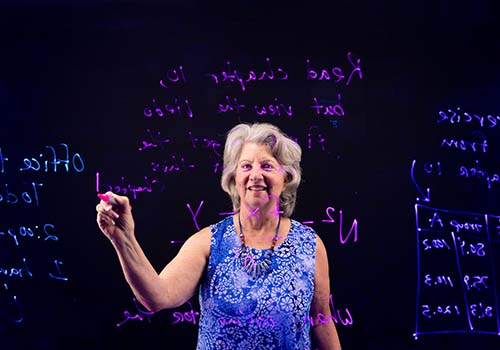Merced College professors grabbed hold of the challenge to quickly turn the college into an online school as the pandemic began. Two years on, they haven’t let go.
Student needs have morphed along the same timeline, so Merced College instructors continue to try to improve the virtual learning experience. And a new team focused on innovation is now dissecting course designs to help them along.
Garrick Grace, Instructional Designer and Faculty Coordinator of the new Innovation Center at Merced College, said before the pandemic, best practices for online learning hinged solely on having quality content and quality interactions.
“But we have to clear the hurdle of how to train faculty, who have learned and mostly taught in an on-campus forum, to teach in and embrace an online forum,” Grace said. “How do we find the balance between traditional methods of teaching and what works well online? We want online courses to mirror a quality on-campus experience as much as possible.”
Merced College established the Innovation Center last summer. The second step was recruiting a team of instructors who were already successful at teaching online. Six faculty support coaches keep daily office hours to advise their peers on everything from recording lectures to structuring assessments.
The old tutorial center was remodeled last summer, and the new Trident Innovation Center now houses a remote worker lounge, a training room and two state-of-the-art recording studios for online lectures and course content.
One studio includes a regular podium for the instructor to stand behind while delivering a powerpoint and lecture. The other features a new clear board that the instructor writes on while facing the camera. The board automatically inverts the text so it presents to the camera and to the students in the right direction.
Math professor Maria Radhika Albert and English professor Keri Ortiz have both contributed to the Innovation Center team and served as faculty support coaches as two of the most experienced online instructors on campus.
Albert came to Merced College in 2013 fully versed in online instruction, after teaching stints with Colorado Technical University and South University in Georgia. But before this latest evolution, she found that most still followed the traditional synchronous model—i.e., presenting content at a certain day and time.
Now students are asking for asynchronous work, which they access on their own schedule. For example, a group project is easy to assign but the most challenging to execute online. This semester, Albert still felt she had to include group projects in her statistics and precalculus courses, which proved to be a challenge.
Her students were required to set up a time to meet online to discuss the assignment and complete the work. Students turned up their noses at the first group project. They actively rebelled against the second.
So Albert changed it to an asynchronous approach. Now students have five days to post their initial responses and discuss their answers with group members. Then they have another two days to finalize a group answer.
“They actually said they feel less isolated doing it that way,” Albert said. “This is what we’re refining right now.”
Ortiz had never taught online courses, as an adjunct instructor or full-time professor, before arriving at Merced College in 2011. But she has embraced new technology—online blackboard, Canvas, TurnItIn—whenever it has come along. She became an instructor for Certified Master Online Instructor Training (CMOIT) starting in 2018.
Now Ortiz can give tips in several areas to help peers refine their online delivery. First, think beyond the types of work one can generate through Canvas, since there is always a way to execute them. Next, write scripts for your lectures before recording. Finally, ask for advice both inside and outside your subject area.
“There are some great workshops being taught by faculty to faculty right now to learn features we haven’t tried,” she said. “It’s a great opportunity to talk about course design. That really has been one of the positives of this whole move online for me, working with fabulous faculty outside of the English department.”
Ortiz said the biggest challenge for the Innovation Center and instructors right now is maintaining consistency throughout a course.
“You can’t spring surprises on students,” she said. “They need to know how an instructor facilitates a class to do well.”
Albert admits to having some mixed emotions about this process.
“Mixed because I’m so passionate about teaching and I really love solving these problems,” she said. “But also because you never see your students when teaching online. … How can we sort out exactly if a student’s difficulty with the subject matter is a course design flaw or a lack of understanding on the student’s part?”
The irony here is that the unknown can be a godsend. When instructors conduct discussions on Canvas in private mode, students can respond without being identified. The anonymity frees them to contribute and increases participation.
“That’s the humanizing part of taking online courses, and that comes from the course design,” Grace said. “We design the interaction to happen. We don’t have to hope for it. You don’t have to blame the lack of exchange within a course on the fact that a class starts at 8 a.m. Students can ‘go to class’ when they’re comfortable—in their pajamas eating Cheetos, if they want to.”
